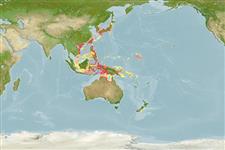>
Gobiiformes (Gobies) >
Gobiidae (Gobies) > Gobiinae
Eponymy: Keinosuke Otaki (d: 1911) was Professor of English at the Imperial Military Academy of Tokyo for a decade, and a former zoology graduate (1894) student at Stanford University (where Jordan was president). [...] (Ref. 128868), visit book page.
More on authors: Jordan & Snyder.
Environment: milieu / climate zone / Tiefenbereich / distribution range
Ökologie
seewasser demersal; tiefenbereich 20 - 35 m (Ref. 559). Temperate
Western Pacific: Japan, Taiwan, Philippines and Indonesia.
Size / Gewicht / Alter
Geschlechtsreife: Lm ? range ? - ? cm
Max length : 6.5 cm TL Männchen/unbestimmt; (Ref. 90102)
Kurzbeschreibung
Bestimmungsschlüssel | Morphologie | Morphometrie
Rückenflossenstacheln (insgesamt) : 6 - 7; Rückenflossenweichstrahlen (insgesamt) : 10; Afterflossenstacheln: 1; Afterflossenweichstrahlen: 10. Characterized by pale greyish brown with blackish blotch at upper rear margin of gill cover, longitudinal row of five, horizontally ovate to rectangular blackish blotches with smaller white spots between on side at level of pectoral fin base, first below spinous dorsal fin and last at midbase of caudal fin; back with about five diffuse saddles and numerous dark brown to blackish spots; white streak on middle of pectoral fin; first dorsal spine of each fin and sharp; fully united pelvic fins, frenum present; rounded caudal fin; longitudinal scale series 27; predorsal scales 7-8; ctenoid scales on body, becoming cycloid on head, pectoral fin base and prepelvic area; fully scaled cheek and opercle; depth of body 4.5-6.2 in SL (Ref. 90102).
Body shape (shape guide): elongated.
Inhabits sand and rubble bottoms (Ref. 90102).
Life cycle and mating behavior
Geschlechtsreife | Fortpflanzung | Ablaichen | Eier | Fecundity | Larven
Masuda, H., K. Amaoka, C. Araga, T. Uyeno and T. Yoshino, 1984. The fishes of the Japanese Archipelago. Vol. 1. Tokai University Press, Tokyo, Japan. 437 p. (text). (Ref. 559)
IUCN Rote Liste Status (Ref. 130435: Version 2025-1)
Bedrohung für Menschen
Harmless
Nutzung durch Menschen
Fischereien: kommerzielles potential
Tools
Zusatzinformationen
Download XML
Internet Quellen
Estimates based on models
Preferred temperature (Ref.
123201): 17.6 - 28.5, mean 27 °C (based on 27 cells).
Phylogenetic diversity index (Ref.
82804): PD
50 = 0.5078 [Uniqueness, from 0.5 = low to 2.0 = high].
Bayesian length-weight: a=0.00724 (0.00339 - 0.01546), b=3.10 (2.92 - 3.28), in cm total length, based on LWR estimates for this (Sub)family-body shape (Ref.
93245).
Trophic level (Ref.
69278): 3.2 ±0.3 se; based on size and trophs of closest relatives
Widerstandsfähigkeit (Ref.
120179): hoch, Verdopplung der Population dauert weniger als 15 Monate. (Preliminary K or Fecundity.).
Fishing Vulnerability (Ref.
59153): Low vulnerability (10 of 100).
🛈
